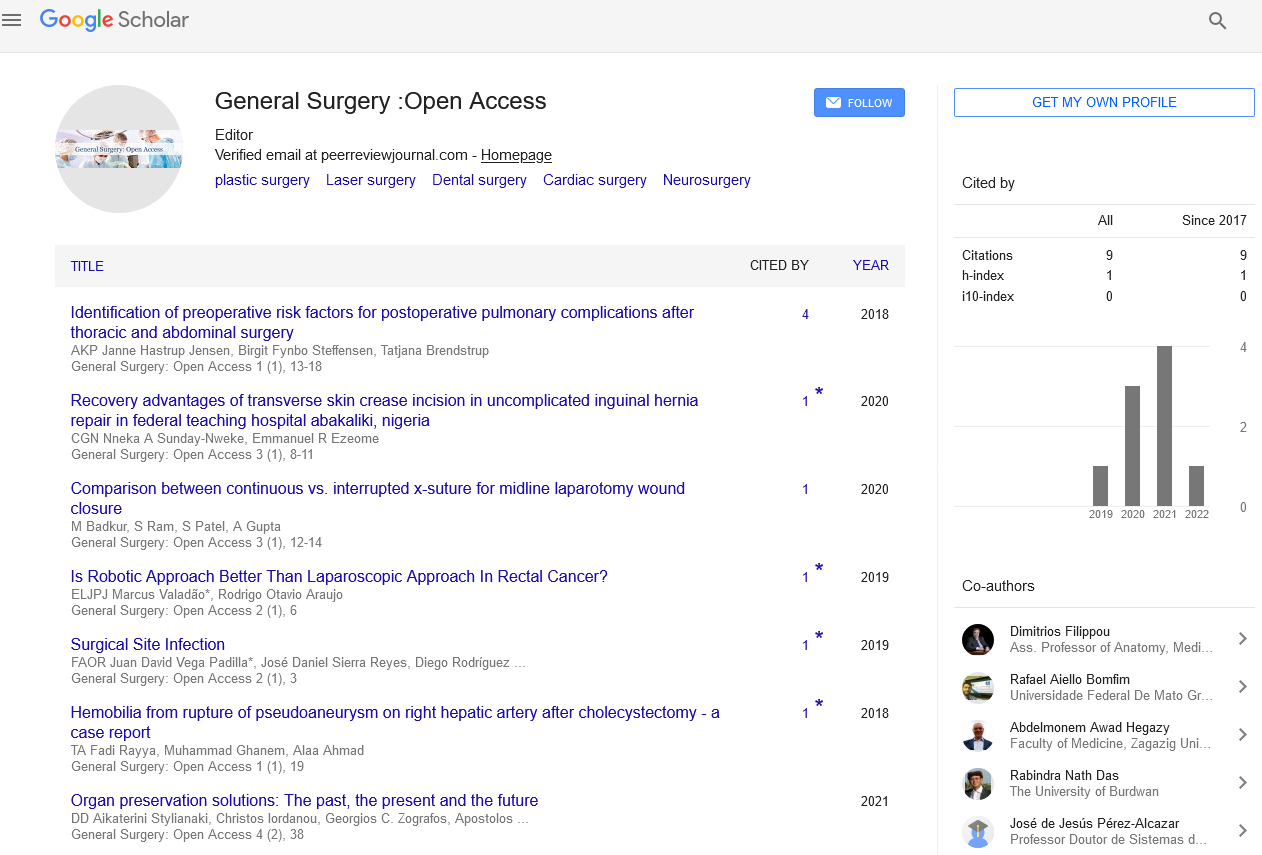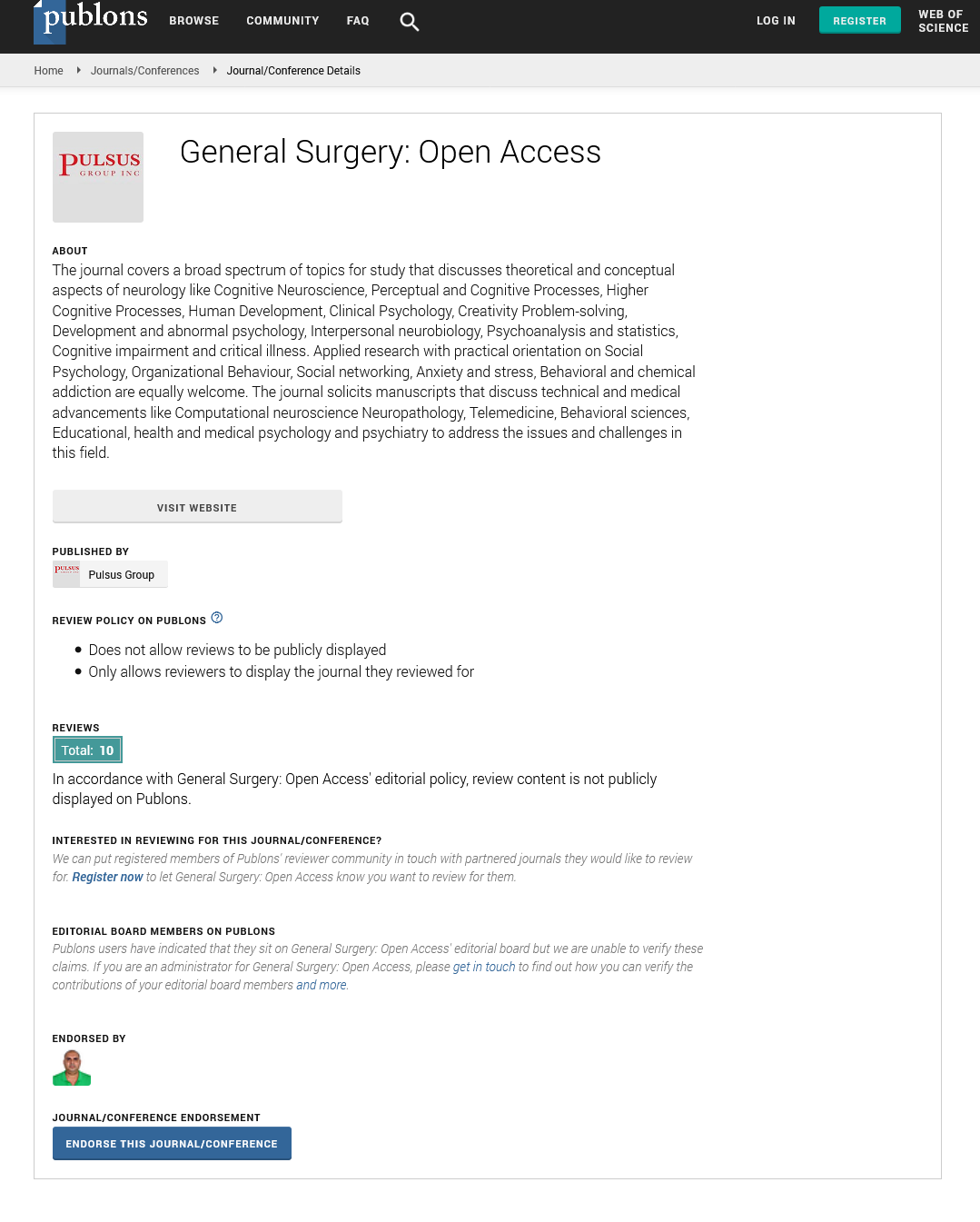Effect of the timing of the health insurance contract on the completion of breast reconstruction
Received: 03-Jan-2023, Manuscript No. PULGSOA-23-6283; Editor assigned: 08-Jan-2023, Pre QC No. PULGSOA23-6283(PQ); Reviewed: 18-Jan-2023 QC No. PULGSOA--23-6283(Q); Revised: 04-Feb-2023, Manuscript No. PULGSOA-23-6283(R); Published: 14-Feb-2023
Citation: Smith, D., Effect of the timing of the health insurance contract on the completion of breast reconstruction. Gen Surg: Open Access. 2023;6(1)3-4.
This open-access article is distributed under the terms of the Creative Commons Attribution Non-Commercial License (CC BY-NC) (http://creativecommons.org/licenses/by-nc/4.0/), which permits reuse, distribution and reproduction of the article, provided that the original work is properly cited and the reuse is restricted to noncommercial purposes. For commercial reuse, contact reprints@pulsus.com
Abstract
The cost of breast reconstruction can create a substantial burden for patients. As patients hope to maximize insurance plan benefits, it is crucial to receive efficient, cost-reducing care. This study analyzes the impact of the insurance cycle Calendar-Based Insurance (CBI) versus Non–Calendar-Based Insurance (NCBI)] on breast reconstruction. Between January 2014 and 2018, patients undergoing postmastectomy breast reconstruction performed by two senior surgeons (N.T.H. and S.S.T.) at a single academic institution were retrospectively evaluated. Data were collected on insurance contract timing (CBI versus NCBI) and insurance payor. Insurance contract cycle and payor impact the timing of breast reconstruction. This study emphasizes the importance of both patient and provider working toward maximizing health insurance plan benefits.
Key Words
Emergency breast, Perioperative care, Perioperative mortality, Quality improvement
Introduction
The complexity of breast reconstruction after mastectomy can considerably increase the cost of treatment, potentially creating substantial burdens for patients and families. As a growing body of research powerfully demonstrated significant qualityof-life benefits of breast reconstruction, postmastectomy breast reconstruction began to be viewed as a necessary part of breast cancer care and recovery [1,2]. The Women’s Health and Cancer Rights Act of 1998 (WHCRA) protects by mandating that health insurance companies supply coverage to all aspects of postmastectomy breast reconstruction; as a result, some of the economic hurdles to care decreased and rates of breast reconstruction began to rise [3].
Although this act transformed the care available to many breast cancer patients, significant disparities in access to care remain [4,5]. Campaigns designed to minimize these disparities and educate women on breast reconstruction options, such as the Breast Cancer Patient Education Act of 2015, have allowed patients to take charge of understanding their options involved with health insurance.
Breast reconstruction after mastectomy is typically a process involving multiple operating room visits. It can become crucial to receive optimal care within an efficient and cost-reducing time frame, as patients hope to maximize their yearly insurance health plan benefits. Although insurance payor status has been associated with differences in rates of reconstruction after mastectomy, the impact of insurance contract timing on breast reconstruction is unexplored. This study aims to bridge this gap in knowledge by analyzing the effect of the insurance contract cycle Calendar-Based Insurance (CBI) versus Non–Calendar-Based Insurance (NCBI) and insurance payor status on the timing of breast reconstructive surgery
Conclusion
The central question of CBI versus NCBI is an essential point for providers to take into consideration when consulting a new patient. The insurance contract cycle affects both the timing and completion of breast reconstruction, providing insight into patient, provider, and insurance payors. As the timing of an insurance contract may impact whether it is financially possible for a patient to complete revision reconstructive procedures, it is important to ensure that breast reconstruction is equally available to every woman wishing to undergo reconstruction, independent of the time of year of breast cancer diagnosis and mastectomy.
Despite the contributions of these findings, limitations remain. First, this study was retrospectively designed and therefore has distinct disadvantages. Second, this study did not account for patient-reported comments on reasons behind scheduling operations during particular times of the year. Third, this study was performed at a single institution and thus may not be fully representative of patients who receive care at multicentre institutions nationwide. However, these findings will help guide patients, providers, and insurance companies.
For patients, this study suggests the importance of cost discussions and reconstructive decision-making tailored with individual health insurance in mind. For a provider, this study predicts the increased demand for revision operations toward the end of the year. Lastly, this study allows insurance payors to predict the timing and cost of insurance claims within the calendar year.
References
- Cederna PS, Yates WR, Chang P, et al. Postmastectomy reconstruction: Comparative analysis of the psychosocial, functional, and cosmetic effects of transverse rectus abdominis musculocutaneous flap versus breast implant reconstruction. Ann. plast. surg. 1995: 1;35(5);458-68.
- Dean C, Chetty U, Forrest AP. Effects of immediate breast reconstruction on psychosocial morbidity after mastectomy. The Lancet. 1983: 26;321;459-62.
- Yang RL, Newman AS, Lin IC, et al. Trends in immediate breast reconstruction across insurance groups after enactment of breast cancer legislation. Cancer. 2013: 119(13);2462-8. [Google Scholar]
[Crossref]
- Wexelman B, Schwartz JA, Lee D,et al. Socioeconomic and geographic differences in immediate reconstruction after mastectomy in the United States. breast j. 2014: 20(4);339-46.
- Albornoz CR, Bach PB, Pusic AL, et al. The influence ofsociodemographic factors and hospital characteristics on the method of breast reconstruction, including microsurgery: a US population–based study. Plast. reconstr. surg. 2012: 129(5);1071-9.






